Slide your feet up the street, bend your back
Shift your arm then you pull it back
Life is hard you know (oh way oh)
So strike a pose on a Cadillac – The Bangles, Walk Like an Egyptian

This week, I thought we’d get back into some more historical pursuits and take a look at the diverse role of music in the cultures we’ve talked about. In part because music may be humanity’s oldest form of expression, and because music was essential to many of the other arts we’ve touched on, including poetry and theater.

Virtually all ancient music began as percussive music: singers and dancers accompanied by drums, rattles, and cymbals. In Egypt, it was the goddess Hathor who was the goddess of music, which she taught the Egyptians alongside Osiris, when the latter was the earthly King of Egypt who brought civilization to the Two Lands. Hathor is called the “Mistress of Music” and “She Who Beats the Drum,” when this aspect of her powers is celebrated, and temple texts refer to the ecstatic, alcohol-fueled dances of her festivals as her highest praise: “The gods play the sistrum for her, the goddesses dance for her to dispel her bad temper.” This harkens back to her other Self, Sekhmet, and how the other gods tamed her rage with beer to make her the Queen of Joy.
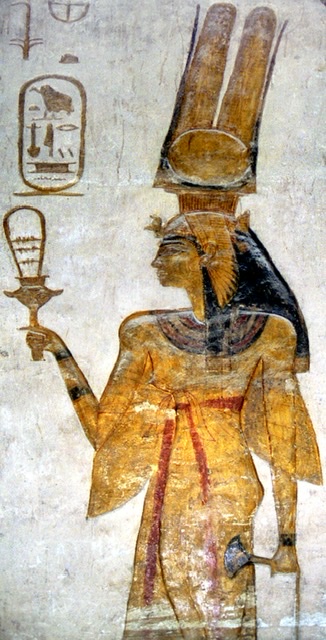
But the temple text from Edfu mentions a particular instrument that was especially sacred to the goddess, and as a result, particularly associated with Egypt: the sistrum. The sistrum (Middle Egyptian: sekhem [sḫm] or sesheshet [sššt]) is a percussive rattle generally made of a brass or bronze frame with several movable crossbars decorated with loose loops or rings. When shaken, the loops/rings move to produce a jangling sound of varying volume dependent on the size of the instrument and its materials. Because the sistrum was so integral to Hathor’s worship, it is common for sistrum handles to depict her face (see below), but the shaking of the sistrum was also thought to avert the over-flooding of the Nile and to frighten away Set in his demonic form, so it wasn’t unusual to see other gods like Isis shown with one in hand. And as the goddess of dance, the cat goddess Bast is also often with a sistrum in her hand. Though that might have less to do with her dominion over dance and more with the reaction any cat will give you when you shake something jangly in their general direction…


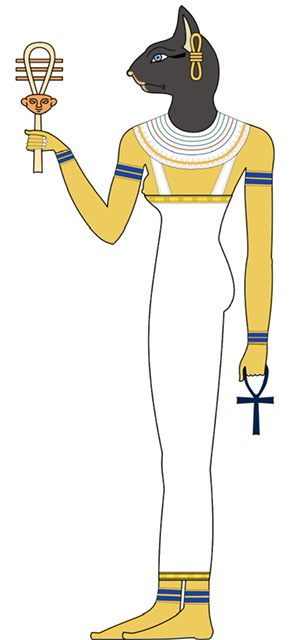
Because of its thousands of years of dominance in the region, ancient Egyptian music and instruments were widespread and popular throughout much of the ancient Middle East, much as the music and film industry in modern Cairo holds vast sway in a similar geographic spread. Any instruments mentioned in the Bible has been found in Egyptian tombs, and much of what our ears consider “Arabic” music has its roots in ancient Egypt. Western musicology tends to describe Arabic music’s tones as divided into quarters, though sometimes thirds. The traditional range of the tones is small and the most ancient songs are not very complex, but it is in the performance that the music is brought to life. Singers embellish the simple phrasing in their pronunciations and add sliding glosses to the notes to enhance a song and make it their own. Below I’ve embedded a video of artist Peter Pringle singing an ancient Egyptian love song accompanied on a harp of the period. While any pronunciation of Middle Egyptian is at best an educated guess, he does a great job of demonstrating the style that a harpist would have sang in.
As for the Greeks, our word music comes from the Greek μουσική (mousike), “art of the Muses.” The traditional nine Muses of Greek mythology are the daughters of Zeus and Mnemosyne, one of the Titans and the goddess of memory. This again makes sense in light of what I said earlier about how it seems so hard to remember where you left your keys, but so easy to remember the lyrics to songs you haven’t heard in twenty years. As a Titan, Mnemosyne didn’t really have much of a cult presence in Greek theology, but it is common for the ancient oral poets like Homer to call upon her at the beginning of their recitals (as he does in both the Iliad and the Odyssey) to help them tell the stories correctly.

Because of the importance of music to the Greek oral poets and the sacred arts, the majority of her daughters, the Muses, are also associated with music. The most obvious being Euterpe (“Delightful”), the muse of music and lyric poetry, but Erato (“Desired”), the muse of love poetry, is typically shown holding a kithara (a type of harp) as is Kleio (“Make Famous”), the muse of history, who is also the muse of lyre players. Lyres are also common in the hands of Terpsichore (“Delight in the Dance”), the muse of dance. But contrary to what one might expect, Terpsichore is usually shown sitting down with her lyre in ancient art, rather than dancing herself. The goddess’ delight is to provide celestial accompaniment to dancers, leading the dance by producing its rhythm. Perhaps sometimes she is accompanying her sister Polyhymnia (“She of the Many Songs”), the muse of sacred poetry, whom is most often shown demurely contemplative, but who also can be leading the sacred dances, as she is in the Roman statue below.
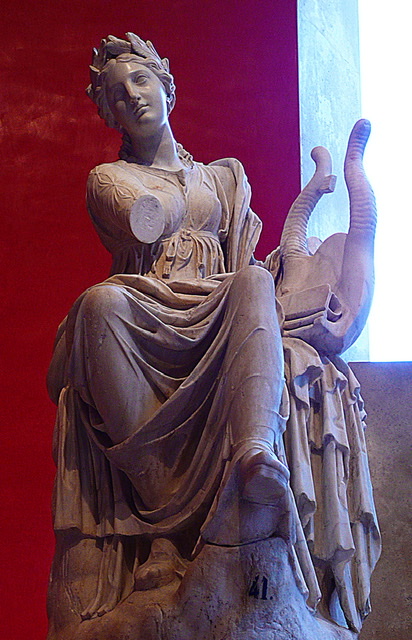
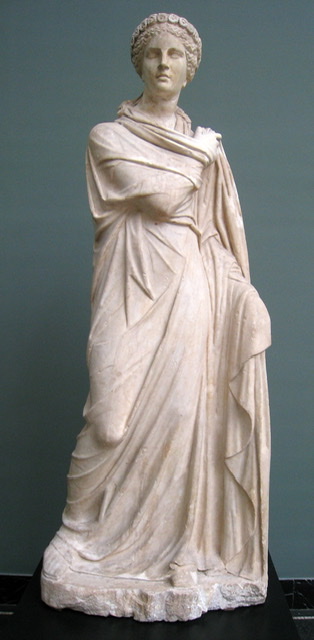
As evidenced by the Muses’ affinity for various harps, as well as the video above, the next stage of instrumental evolution for ancient music really fell into two major categories: string and wind instruments. While the earliest versions on any of these instruments came out of Sumer and Egypt, their designs weren’t radically different in Greece or Rome, which, aside from cultural dominance, is part of the reason ancient music has a fairly similar sound throughout this region. Most music we’ve been able to reconstruct is in a minor key, and especially in the realm of wind music, has the flat register of many modern reed wind instruments. This is in part because while we tend to carelessly call ancient wind instruments “flutes,” most of them in this part of the world were reeded instruments closer to oboes or clarinets.



Perhaps the most common of these was a reeded, double-piped wind instrument which in Egypt would have been a single-reed instrument called the zummāra, and in Greece would have been the double-reeded aulos. In both instruments, one pipe was used to produce a melody and the other to produce a drone, as you would with bagpipes. The aulos was supposedly invented by the goddess Athena, but she disowned it because of the way one must puff out one’s cheeks to play it, so it is more associated with satyrs, and the satyr Marsyas in particular. Because of this satyric connotation to the instrument, the aulos was also associated with Dionysus and his bacchae, who were usually shown in their ecstatic revelry with satyrs in tow. And it is this connection to Dionysus that most likely led to Arsinoë’s dad, Ptolemy XII Auletes being such a fan of the instrument.

Ptolemy XII, like many Egyptian and Egyptian-pretending pharaohs, loved epithets. For example, among his five ruling names, just his serekh was Hununefer Benermerut Tjenisunebtrekhyethenakaf Duaenefkhnmushepesershesepenefkha’emnesu Sensenensehnuemhaawminedjetitef Tjehenmesuthernesetitefmihorkanakht Itypesedjemtamerimihapuankh Redienefhebusedashauwerumiptahtatjenenitnetjeru. Which, for the record translates to: The perfect youth, pleasant in his popularity, whom the Two Ladies and the common folk have elevated along with his ka, who the wonderful Khnum praises so that he receives the crown of kingship, who unites himself with the works (of his father) in joy like that which his father protects, who is shining at birth on the throne of his father like Horus, the strong bull, the lord who lights up Egypt like the living Apis, to whom many great Sed festivals will be given through Ptah-Tatenen, the father of the God.

But his original praenomen was Philopator Philadelphos, “Beloved of his Father and Brother,” to bind him to his father, Ptolemy IX, and his brother (also named Ptolemy), who had fought by his side and whom he’d made the client King of Cyprus. This might have been especially important if certain ancient historians are correct and Ptolemy XII was the son of one of his father’s concubines and not his legitimate queen. He also used these titles to erase the short and violence-steeped reigns of his uncle Ptolemy X (died trying to invade Cyprus) and nephew Ptolemy XI (torn apart by an Alexandrian mob, aka the Hypatia Special). But as my God’s Wife readers know, eventually he throws his Cypriot brother to the Roman wolves and is too busy trying to outwit his sister-wife Cleopatra V (or VI, depending on your sources) Tryphaena to really care about upholding his father’s name anymore. After his spat with his usurping queen and rebellious daughter, Berenice IV, Ptolemy regains his throne with the help of Rome and Pompey in particular, and decides it’s about time for a new ruling praenomen. He chooses Neos Dionysos (New Dionysus), to cement his status as the “resurrected” pharaoh of Egypt; Dionysus being associated with Greek pre-Christian resurrection myths because he descends into the underworld to rescue his mortal mother, Semele.
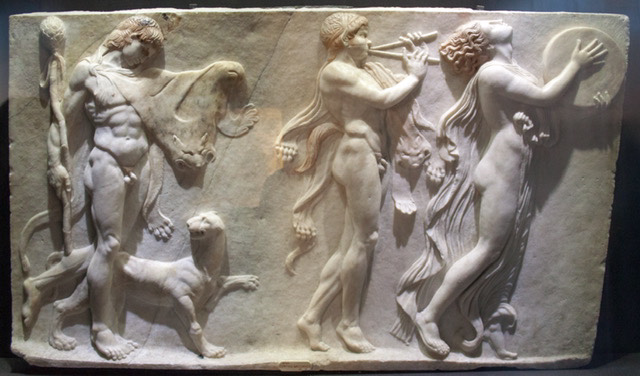
But it’s this fondness for Dionysus (and all of the drinking and carousing the god represents), that led the later Greek historian Strabo to give Ptolemy XII the epithet Auletes, the one we know him the best by. He writes, “Now all of the kings after the third Ptolemy, being corrupted by luxurious living, administered the affairs of government badly, but worst of all were the fourth, seventh, and the last, Auletes, who, apart from his general licentiousness, practised the accompaniment of choruses with the flute, and upon this he prided himself so much that he would not hesitate to celebrate contests in the royal palace, and at these contests would come forward to vie with the opposing contestants.” Compare this to how historians of Strabo’s time would also ridicule the Roman emperor Nero’s obsessions with acting and playing music to the detriment of his empire. Rulers were praised for being cultured, but one couldn’t be so to excess, and Ptolemy XII was clearly thought to have crossed that line, being so caught up in his aulos that he would lose his kingdom and have to crawl to Rome for assistance.
But to give you a feel for the aulos’ sound, I’m embedding a video of an aulete accompanying a singing of the Delphic paean to Apollo, the Greek god of music, written by Athenaios of Athenaiou.
Another type of ancient Greek pipe that is perhaps more familiar is the pan flute, so named for their creator, the satyr god Pan. This instrument is also sometimes called the syrinx, in honor of the nymph they were first made of. As our old friend Ovid relates in The Metamorphoses, Pan is pursuing Syrinx and she asks for her sister river nymphs to turns her into hollow water reeds to avoid his advances. Frustrated, the God’s breath huffs across the reeds and he becomes equally enchanted by their haunting melody, so he cuts the reeds into a blown-end flute that will produce the same sound. A pan flute can be made of any hollow, cylindrical material (the Greeks favoring reeds, but other cultures would use plants like wood or bamboo) with several of these cylinders of unequal lengths bound together. Blowing across them will produce different tones depending on the length of the cylinder in question; pan flutes can also be closed at one end to produce a lower pitch, and small obstructions such as pebbles introduced to alter the sound.

In contrast to the wild pipe parties Dionysus and his satyr friends were on about, and in spite of the proceeding video, Apollo tended to favor the various ancient harps, just as his beloved Muses did. Apollo is generally portrayed as the opposite of Dionysian excess, and his taste in music reflects this. The most simple of the Greek harps was the lyre, a small harp with (traditionally) a tortoiseshell soundbox with two outward-curving arms rising up from it, strung with gut strings. The lyrist would pluck the strings with a plectrum and use the fingers of their other hand to silence the strings when necessary.

The next size up from the basic lyre was the phorminx (φόρμιγξ), which was slightly more complex, having a wooden frame and soundbox. The phorminx was crescent-shaped and could have anywhere from two to seven strings. It was the more professional instrument during Homer’s time, but ultimately it would be supplanted by the most sophisticated of the Greek harps, the kithara.

The kithara (κιθάρα) was a large (though still lap-sized) seven-stringed wooden lyre, with a deep soundbox. While the lyre was perceived as the instrument of folk music and beginners, the kithara was the instrument of professionals, hence the attachment of the Muses to it. Its musicians, called kitharodes, played with plectrums made of stiffened leather, and while most ancient sources agree that seven was the standard number strings for the instrument, especially talented kitharodes might add more to better show off their skill.

As mentioned, ancient poets typically accompanied themselves on musical instruments to keep cadence and to embellish their spoken words, in part because much of ancient poetry was recited in a space between singing and speaking— more of a rhythmic chanting. The poet Sappho (c. 630s-570s BC), often referred to as the Tenth Muse, was said to have climbed Mount Parnassus to the grove of the Muses, where she used Apollo’s own plectrum to skillfully play the kithara for the Muses while the goddesses danced to her music.

Whether or not that actually occurred, Sappho was known for her musical abilities as well as her poetry in the ancient world. Her poetry was lyric poetry, literally poetry to be recited to the lyre, and music features heavily in the surviving fragments of her work that we have. She, along with her contemporary and friend Alcaeus of Mytilene, created two of the most important classical stanza forms, the Alcaic and Sapphic, which are named for them. The Alcaic meter is a pair of lines of eleven syllables, followed by a line of nine syllables and then one of ten; while the Sapphic is a pair of lines of eleven syllables, followed by one line of eleven syllables and one of five. Both of these meters would continue to be used through the Roman period, the poet Horace being especially fond of them.

But to hear how Sappho’s poetry would have sounded to her contemporary audience, below is a video of artist Andrea Goodman singing an arrangement of one of Sappho’s poem, accompanying herself on a seven-string lyre.
Lastly, to bring the Romans in, I’m going to touch briefly on trumpets and early brass wind instruments. While in no way the inventors of the trumpet (simple straight trumpets being found in King Tut’s tomb, as well as being a fixture in most ancient armies), the Romans deserve some credit for having so many kinds of trumpets. Their version of the straight trumpet was called (confusingly) the tuba— a long, straight trumpet with a detachable conical mouthpiece. This instrument had no valves, so how much differentiation in sound was probably minimal and limited to what changes in airflow the musician could make with their mouth.

A variation on this design was the cornu (which is literally the Latin word for “horn”), which was a sort of proto-French horn. It, too, had a detachable mouthpiece and curved around the body of the musician in a large G shape. A similar instrument was the buccina, another large, curving trumpet, the difference between the two seeming to rest on the buccina having a long bar reinforcing the middle part of the tubing. Though some instruments called cornu have this bar, too, so perhaps the terms were used somewhat interchangeably, or the two horns had different tones that we are unaware of from an archeological perspective.


This is supported by the Roman writer Vegetius in his work De Re Militari, where he states: The tuba sounds the charge and the retreat. The cornets are used only to regulate the motions of the colors; the tuba serve when the soldiers are ordered out to any work without the colors; but in time of action, the tubas and cornets sound together. The classicum, which is a particular sound of the buccina or horn, is appropriated to the commander-in-chief and is used in the presence of the general, or at the execution of a soldier, as a mark of its being done by his authority. The ordinary guards and outposts are always mounted and relieved by the sound of tuba, which also directs the motions of the soldiers on working parties and on field days. The cornets sound whenever the colors are to be struck or planted.

In addition to their military uses, all of these horns were used during games, festivals, and public events on the home front; as were versions of all of the Greek instruments we’ve discussed and typical period percussion instruments. Because if the ancients all agreed on one thing, it was you couldn’t have a good party without music— be it Sappho’s garden gatherings amongst her favorite girlfriends, or the biggest triumphal games Julius could throw himself.
Leave a reply to Jason R. Abdale Cancel reply